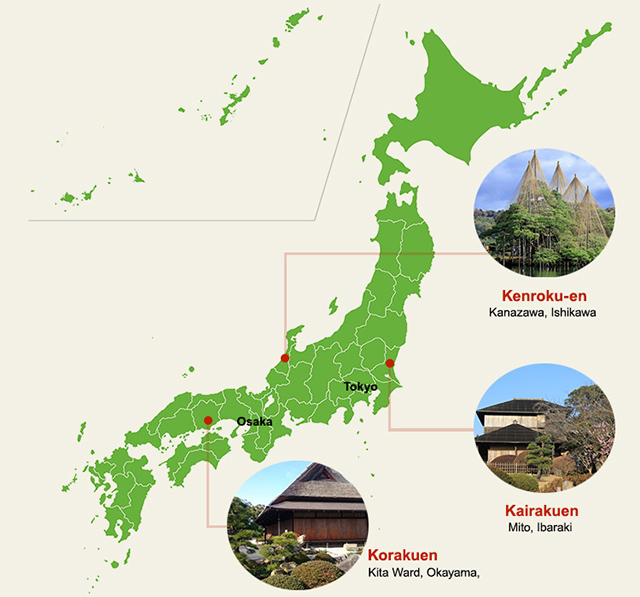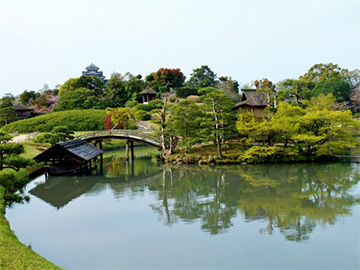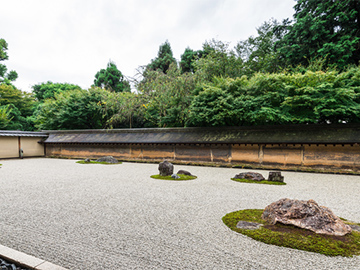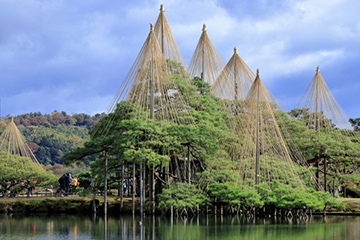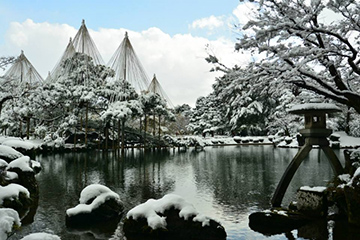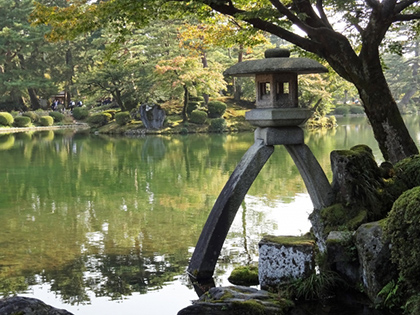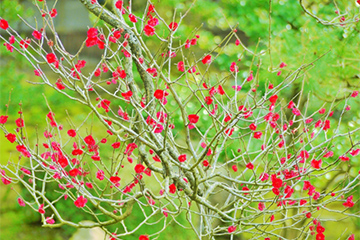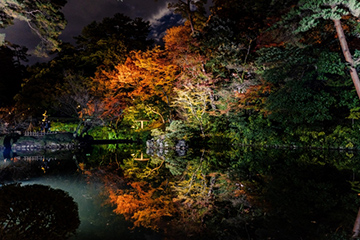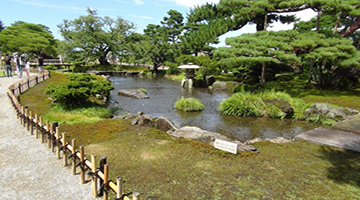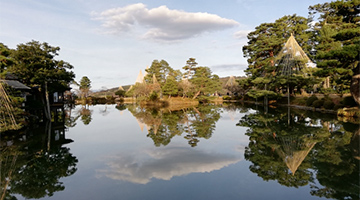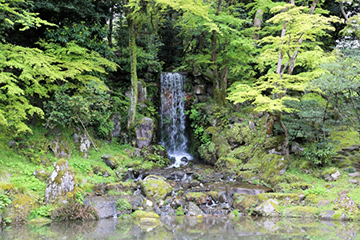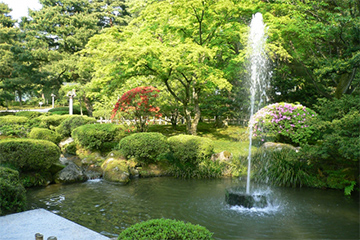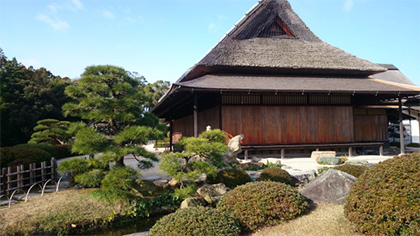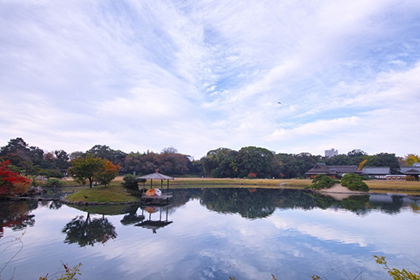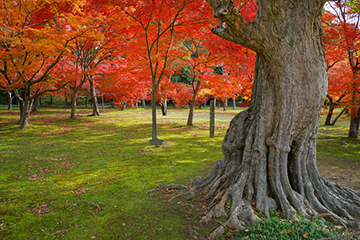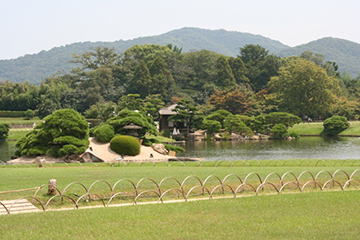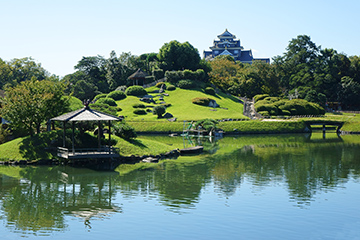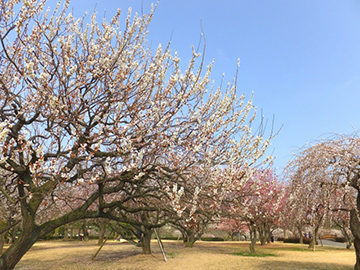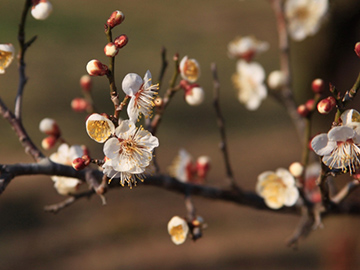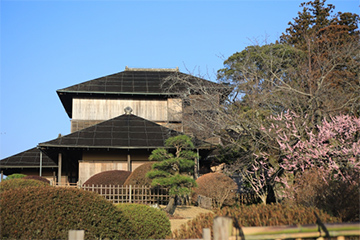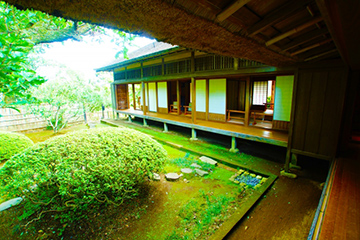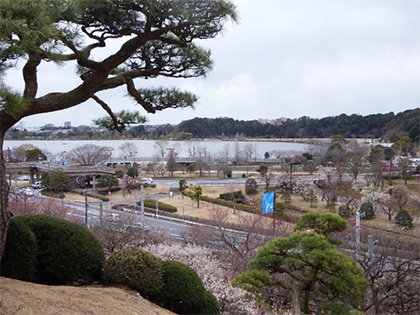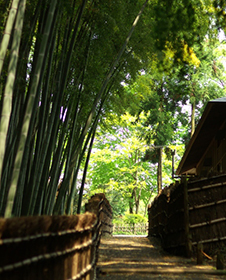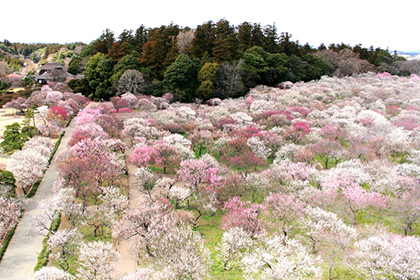Web Japan > Trends in Japan > Food & Travel > Visit the “Three Great Gardens of Japan” to Enjoy a Stroll, Get Close to Nature, and Relax as You Look at the Scenery
Visit the “Three Great Gardens of Japan” to Enjoy a Stroll, Get Close to Nature, and Relax as You Look at the Scenery

Koraku-en in Okayama is one of the Three Great Gardens of Japan
This article introduces Japan’s three most famous gardens: Kenroku-en, Koraku-en, and Kairaku-en.
These gardens came to be known as the “Three Great Gardens of Japan” around the end of the 19th century, though it is not known who originally came up with this name. Each of the three gardens is allocated with a symbolic aspect of the beauty of nature: “snow,” “the Moon,” and “flowers,” respectively.
Japanese gardens have several different styles. For example, “Karesansui” is a very famous format of Japanese garden, and is featured in the garden at Ryoan-ji in Kyoto. These gardens represent rivers, waterfalls and other facets of Mother Nature by using only sand and stones, and feature no water. However, all of the “Three Great Gardens of Japan” were created by feudal lords in the Edo Period (1603–1867) in a style called “Chisen Kaiyu-shiki,” that focuses on ponds, unlike Karesansui.
The Chisen Kaiyu-shiki style is not designed to be viewed from inside a building like with Karesansui. Instead, gardens in this style include large ponds and hills with teahouses and other small buildings at different parts of the landscape, and they are designed for people to stroll through the entire area as they go to see each feature. Feudal lords, or Daimyo are warriors who used to rule over feudal domains across Japan in the past. The gardens that these feudal lords made are called “Daimyo Teien,” or “feudal lord gardens.” These gardens feature a large pond in their center, with a path to walk around it.
Snow—Kenroku-en is Famed for Its Yukitsuri in Winter, as Well as for Its Stone Lantern
Kenroku-en (Kanazawa City, Ishikawa Prefecture) is completely covered in a layer of snow during the winter months. The ropes stretching up to the sky in cone shapes on the trees are a famous feature of the garden. Also known as Yukitsuri, these ropes are strung between the tree branches and the top of a pole installed beside the tree, preventing the branches from breaking due to snow settling on them. If the tree has a strong trunk, the ropes are attached to the trunk instead of a pole.
Kenroku-en is also famous for the Kotoji-toro, a lantern that stands beside the Kasumi Pond. This lantern is made of stone, but its legs are different from other lanterns. Generally, outdoor lanterns are built with three legs each, but the Kotoji-toro has only two legs. Its shape resembles a Kotoji (the small pillars that support the strings on the traditional Japanese instrument called the koto), which is why it is called Kotoji-toro. What’s more, each of its legs are of different lengths, with one underwater and the other on land.
Kenroku-en is beautiful in other seasons beside winter. As spring approaches, a plum grove produces wonderful blossoms with some 200 trees in about 20 varieties. In the spring months, some 420 cherry trees come to bloom. In fall, some 340 maple trees, some 60 zelkova trees, and other foliage change color to red or yellow in rapid succession.
The garden’s walking paths and waterways are designed to form winding lines within the grounds. Unlike the symmetrical, geometric shapes commonly found in European gardens, gardens in Japan feature many curves in order to imitate natural fields and mountains. These gardens are creatively designed so that the scenery changes each time you move, preventing you from getting tired of the view.
The waterways that meander around Kenroku-en flow into the Kasumi Pond from a point beside the Kotoji-toro.
The Kasumi Pond was created to pray for long life and eternal prosperity on the basis of Taoist thought. The pond represents the vast sea, and the island within it is called Horaijima—a legendary location where immortal ascetics are said to live.
The water in the Kasumi Pond flows through the Midori-taki Waterfall and a fountain before entering another pond called Hisago-ike. With a height of 6.6 meters, the Midori-taki Waterfall is a majestic sight and has a strong flow of water. The garden has what is said to be Japan’s oldest fountain, powered by the water pressure created through the difference in height with the Kasumi Pond. It gushes out water about 3.5 meters high, about the same height as the water level in the Kasumi Pond.
Moon—Koraku-en Incorporates the Mountains and a Castle Outside into Its Landscape
Koraku-en in Okayama (Okayama City, Okayama Prefecture) was awarded three stars by the Michelin Green Guide Japan along with Kenroku-en.
Koraku-en in Okayama is situated on a river island, with Okayama Castle standing at one of the riverbanks nearby. Once you go through the main entrance of Koraku-en, you will soon see a building called the “Enyo-tei.” This was built as a parlor for Ikeda Tsunamasa, the feudal lord of Okayama who created Koraku-en about 300 years ago. Koraku-en is designed to feature beautiful scenery wherever you look, but the Enyo-tei was made to overlook the entire garden, and offers the best view of all. Tsunamasa enjoyed Noh plays, and so a Noh stage was built next to the Enyo-tei.
In front of the Enyo-tei is the Marsh Pond, situated in the center of the garden. The Marsh Pond has three islands: Naka-no-shima with an island teahouse (Shima-jaya), Mino-shima with a pavilion (Tsuridono) standing on the pond, and Jari-jima with beautiful white sand and green pine trees.
An artificial hill called Yuishin-zan can be found to the south of the Marsh Pond, and it has rhododendrons and azaleas planted on it. Large cherry and plum groves are located to the east of Yuishin-zan, and so you can enjoy viewing Japanese irises, lotuses, and other flowers and blossoms all year round. The park also features a grove called Chishio-no-mori with almost 100 maple trees that look incredibly beautiful when their leaves change color in fall.
A mountain called Sozan can be seen beyond the Marsh Pond, and it appears to be part of the scenery in the garden despite being located far away. A moon-viewing party is held every fall, where people look at the harvest moon rising from the ridgeline of Sozan. The garden is located in an urban area, but no buildings get in the way of the view.
This technique is known as “Shakkei” in Japanese. This is a common technique found in Japan and other gardens in Asia, and it involves creating a design so that the outside scenery is incorporated into the landscape as if it was part of the garden.
Flowers—Kairaku-en Allows You to Enjoy the Beauty of Plum Blossoms and the Serenity of Bamboo and Cedars
Kairaku-en (Mito City, Ibaraki Prefecture) has the symbol of “flowers,” and it is particularly famous for its plum blossoms. The garden’s plum grove features some 3,000 trees of 100 varieties that all bloom together in March. Kairaku-en was created by Tokugawa Nariaki, the feudal lord of Mito. He planted these trees to prepare a reserve of umeboshi (plums pickled in salt and then dried in the sun) as a source of nutrition in case of famine or war.
The villa called Kobun-tei in the garden is said to be designed by Nariaki himself, and its name derives from “Kobun-boku,” another word for plum tree in Japanese. Nariaki sought to open up Kairaku-en and make it a place for him to enjoy along with all the ordinary residents in his territory. As such, he included several creative features in the garden, such as by making a large wood deck room in the Kobun-tei.
Kairaku-en is a rare example among feudal lord gardens in that it does not have a large pond like those seen in Kenroku-en and Koraku-en. This is because Kairaku-en incorporates the Senba Lake as part of the scenery in Shakkei style.
The layout of Kairaku-en is said to express a harmony between Yin and Yang. The western half of the garden represents Yin with thick forests of tortoise-shell bamboo and cedar, and the bright plum grove in the north-east represents Yang.
In the present day, many visitors enter the garden through the eastern entrance that is near to the station and that lets them see the plum groves soon after visiting.
However, the originally intended main entrance is at the front of the garden, and is painted in black. After going through this entrance, you walk along a dark path within bamboo groves and cedar forests, pass through several gates. When you reach the Kobun-tei, the scenery changes completely. The villa has an elevated area overlooking the whole of the Senba Lake, and the large plum grove is also visible right in front of you. You can thoroughly appreciate the concept of Yin and Yang in Kairaku-en by following this course.
Japanese Gardens Feature Changing Scenery and Many Creative Design Directions
As you can see in the three gardens mentioned above, Japanese gardens use paths, waterways, groves, artificial hills, and other features to make the landscape seem larger than it is in reality, to create dynamic changes in the scenery, to orchestrate dramatic developments, and to achieve other kinds of creative design.
Why not visit a garden in Japan? You can get in touch with nature while enjoying the features of a veritable theme park that is full of changes despite being quiet and peaceful.
